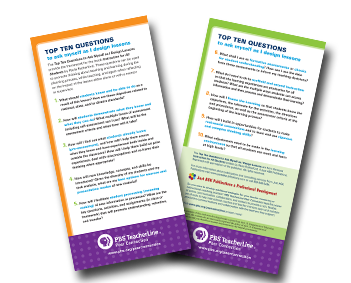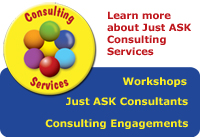
Volume X Issue II
Share this newsletter on
CSI: Classroom Success Investigation

Bruce facilitating a Leading the Learning® workshop
It has happened to all of us at one time or another. We work hard to put together a plan that looks great on paper but does not meet our expectations when implemented. While some educators attribute this lack of success to the adage “the best laid plans… often go awry,” others view the unfavorable outcomes as an opportunity to refine their plans for future use. Instead of resorting to an “it is what it is” attitude, they perform a CSI: Classroom Success Investigation so that they can put practices and procedures into place that ensure greater success down the road.
This issue of Just for the ASKing! provides insights and reminders about steps teachers can take before, during, and after lessons that can lead to more propitious outcomes. The practices described here provide food for thought about how we can solve some of the problems getting in the way of classroom success.
Capture students’ attention before you begin
Some teachers begin lessons by starting to talk. Some students are still getting out their materials, others are engaged in private conversations, and a few are listening to the teacher. These teachers continue the lesson introduction ignoring the inattentiveness with the reasoning that when the students finally recognize that the lesson has begun, they will focus their attention in their direction. The problem is that these students may not be able to follow the directions and explanations since they have missed a vital part of the lesson’s introduction; they exist in limbo for the rest of the period or lesson. Some may be able to catch on while others may never get the gist of what they are supposed to be doing. It is essential that teachers take the time to ask for student attention and wait until everyone is ready and focused. Ensuring that 100% of the students are ready to learn from the get-go is essential if the lesson is going to work.
Make expectations for student learning and lesson outcomes clear
Today, lesson objectives and/or essential questions are generally posted in a prominent place in classrooms. Most are in language students can understand. The problem is that some teachers fail to call attention to the lesson goals or even mention them at all, assuming that the students will read what is posted. When teachers do not review the lesson outcomes and identify the components of the objectives in words that all students can understand, the notations on the board simply take up space instead of having a real purpose in the success of the lesson. One principal recently expressed her frustration at this practice by equating it to the signs often posted in public restrooms saying that all employees must wash their hands before returning to work; we have all seen these signs so often that we eventually ignore them completely. Students react that same way unless attention is drawn to the objectives as the teacher explains expectations for learning and connects upcoming learning experiences to the objectives.
Watch for telltale signs
While some practitioners seem to be unaware of what is happening around the classroom, consistently successful teachers have their antennae up at all times. Jacob Kounin called the skill of watching for telltale signs “withitness.” There are certain signals that teachers can watch for that indicate that things may not be going well. Some students may be doodling, others may be staring out the window, and still others may be surreptitiously looking at a video game or cell phone which they think they have hidden from the teacher’s view. These behaviors may be early indicators that the lesson may not go well. Astute individuals will see these markers as signals that they need to use proximity or pause and wait for all students to focus their attention. Although teachers may feel some inner frustration, it is important for them to remain calm and reiterate realistic expectations.
Keep moving around the classroom
The savviest teachers move around the classroom as a matter of course whether they are involved in direct instruction or whether their students are working independently or in small groups. They believe that circulating and staying in close proximity to their students helps them monitor the progress that students are making and assure that students are working successfully on the task at hand. Sitting behind a “teacher’s” desk, working on a computer, or having barriers like empty desks separating teachers from students can send an unintended message to students: I have my work and you have your work. The students’ work is the teacher’s work. Additionally, when students know that their teacher is paying close attention to their work habits, there is a greater likelihood that the learning task will be accomplished, and, as a result, the lesson will be a success. Fred Jones calls this strategy “management by walking around,” and further says, “If you don’t work the crowd, the crowd will work you.”
Do more asking, less telling
Student involvement in any lesson is the key ingredient for achieving classroom success. When teachers talk for extended periods of time, it is likely that student minds will wander and attention will be diverted. Observant teachers realize that lessons often begin to falter when they spend too much time “telling” students as opposed to “asking” students. The goal of any promising lesson is to have full student attention, enthusiastic involvement, and evidence of real learning. These outcomes can occur when teachers plan ahead and devise thought-provoking questions that will stimulate class discussions. These questions must move beyond fact-based answers and challenge students to make personal connections to the content, reach and defend conclusions with text-based evidence, and share “out-of-the-box” ideas. Finally, rewarding lessons must involve the majority, if not all, students. The other side of the coin is “winging it” with low-level questions that only involve a handful of students at best. “Who can tell me…?” is a recipe for disaster.
Plan transitions carefully
Lessons can deteriorate when teachers do not think ahead about transitions. It is unfortunate that good plans can fall apart when what is expected from students as they move from one segment of the class period to the next activity is not explicitly communicated. Before students move, scrupulous teachers make sure to explain the purpose of the upcoming learning, the expectation for student involvement, the outcome of the session, materials that will be required, how to procure those materials, and the amount of time the students will have to complete the task. After providing all of these details to students, wise teachers ask the students to explain to a fellow student exactly what is expected to happen. And finally, when teachers give students an exact amount of time to move into the next activity, it makes it a fun challenge for students and often gets students where they are supposed to be much more quickly.
Avoid pressing on
Astute teachers plan ahead about how lessons will unfold. They may even play a mental movie of the class in their heads. This admirable practice may not always lead to the hoped for success because the classroom is full of somewhat unpredictable students. As lessons unfold, teachers must be mindful of whether or not they are going well. When teachers press on with lessons despite negative signs such as fidgeting, side conversations, confused looks, and even disruptive behavior, the lesson simply won’t be successful. In extreme cases, teachers may seem oblivious to signs that their students are not with them. In post-conference conversations, teachers often defend the practice of “pressing on” by saying that they have so much to cover and that moving on with the lesson is necessary so they can stay on schedule. Although there is indeed a great deal of content to be addressed, when students become inattentive or even agitated, no learning is occurring. Pausing, taking a breath, thinking clearly, and considering alternative approaches to the lesson is the only smart recourse.
Avoid death by PowerPoint
For some educators, the use of PowerPoint has become their main mode of presentation. When students enter a classroom and see evidence that the teacher will present yet another PowerPoint, one can almost see the disappointed looks on their faces. Whenever teachers use PowerPoint presentations as a method of instruction, there are readily available guidelines about the proper font to use, the amount of content to put on a slide, and ways to involve the students as the presentation unfolds. Additionally, some teachers require students to copy information from the presentation; this is an ineffective practice because students cannot attend to the visual presentation, the verbal explanation, and be expected to write at the same time. Supervisors and evaluators decry the overuse of PowerPoints because students almost become withdrawn and even indifferent because they have been subjected to so many such presentations in the past. Some students even see their use as opportunities to tune out because they realize that their expected participation will be limited or even non-existent.
Show respect for students
One key ingredient that can have a huge impact on a lesson’s success is the manner in which a teacher demonstrates respect for students. Young people are acutely aware of how a teacher interacts with students, and when a teacher displays sensitivity to the needs of their young charges, they respond in kind and lessons have the potential to flourish. There are small ways teachers can show respect including calling all students by name, never embarrassing students by putting them on the spot, helping students achieve success in front of their peers, never resorting to the use of sarcasm, and displaying an upbeat attitude through facial expressions, voice tone, and enthusiastic love of one’s subject. Lessons rarely fail in classrooms where mutual respect is in place.
Have students put the pieces together
We have all heard the story of the parents who ask their child what they learned in school today only to have the youngster reply, “Nothing.” Their inability to talk with any specificity about their learning can perhaps be attributed to their own lack of involvement; however, it could also be caused by the lack of clear communication of the outcomes for the day’s lesson. There is an easy fix: all educators plan all lessons with two distinct questions in mind:
- What are students supposed to learn?
- How are the students and I going to know when that learning has occurred?
To solidify this way of thinking, it is imperative that teachers take the time to wrap up their lessons by providing a summarizing activity which will enable the students to answer those questions. When classes end in a flurry of activity with no opportunity for students to put the pieces together, the answer to that parental question will most likely continue to be, “Nothing.” One fun and easy way to provide closure is to simply ask students, “When someone asks you what you learned today, what two concepts, vocabulary words, or processes will you describe?”
Aim for rigor and minimize busy work
It is confusing and even disconcerting when supervisors and evaluators talk about the on-going proliferation of worksheets and the assignment of mundane activities for students to complete in today’s 21st century classrooms. These practices seem especially counterproductive given the learning expectations enumerated in the Common Core State Standards. It is the moral imperative for all educators to fill their classrooms with challenges, excitement, stimulation, intrigue, and even enjoyment. These ends can be achieved when we build rigor and relevance into lessons. Successful teachers express their dismay when they hear complaints from their peers that children are apathetic, unproductive, and indifferent to learning. These conscientious professionals rarely have lessons “go south” because they have changed with the times, discovered ways to involve their students every day in meaningful ways, and are constantly aware that their job is to prepare their students to be thinkers, problem solvers, creators, and visionaries.
And last, but certainly not least, collaborate with colleagues
Research has shown that one of the reasons many teachers leave the profession early in their careers is a sense of isolation. Today, educators in many schools are organized in collaborative teams. When such structures are in place, teachers are provided opportunities to engage in practices advocated by Judith Warren Little, Dean of the Graduate School of Education, University of California Berkley; those practices include frequent concrete talk about teaching and learning and asking for and providing one another assistance. Such collaborative practices (investigations?) not only reduce the sense of teacher isolation but, as research has shown, also lead to classroom success.
Permission is granted for reprinting and distribution of this newsletter for non-commercial use only. Please include the following citation on all copies:
Oliver, Bruce. “CSI: Classroom Success Investigation.” Just for the ASKing! Fabruary 2013. Reproduced with permission of Just ASK Publications & Professional Development (Just ASK). © 2013 Just ASK. All rights reserved. Available at www.justaskpublications.com.
Free Top Ten Tips to Ask Myself as I Design Lessons
“These questions can be used to promote thinking about teaching and learning during the planning process, while teaching, and again when reflecting on the impact of the lesson either alone or with a mentor or supervisor.”




